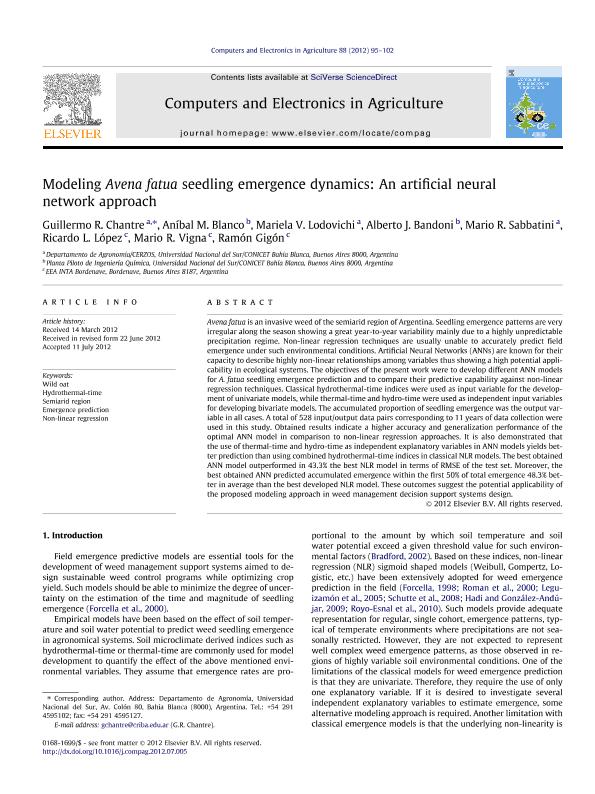Artículo
Modeling Avena fatua seedling emergence dynamics: An artificial neural network approach
Chantre Balacca, Guillermo Ruben ; Blanco, Anibal Manuel
; Blanco, Anibal Manuel ; Lodovichi, Mariela Victoria
; Lodovichi, Mariela Victoria ; Bandoni, Jose Alberto
; Bandoni, Jose Alberto ; Sabattini, Rafael Alberto; López, Ricardo L.; Vigna, Mario Raul; Gigón, Ramón
; Sabattini, Rafael Alberto; López, Ricardo L.; Vigna, Mario Raul; Gigón, Ramón
 ; Blanco, Anibal Manuel
; Blanco, Anibal Manuel ; Lodovichi, Mariela Victoria
; Lodovichi, Mariela Victoria ; Bandoni, Jose Alberto
; Bandoni, Jose Alberto ; Sabattini, Rafael Alberto; López, Ricardo L.; Vigna, Mario Raul; Gigón, Ramón
; Sabattini, Rafael Alberto; López, Ricardo L.; Vigna, Mario Raul; Gigón, Ramón
Fecha de publicación:
11/08/2012
Editorial:
Elsevier
Revista:
Computers and Eletronics in Agriculture
ISSN:
0168-1699
Idioma:
Inglés
Tipo de recurso:
Artículo publicado
Clasificación temática:
Resumen
Avena fatua is an invasive weed of the semiarid region of Argentina. Seedling emergence patterns are very irregular along the season showing a great year-to-year variability mainly due to a highly unpredictable precipitation regime. Non-linear regression techniques are usually unable to accurately predict field emergence under such environmental conditions. Artificial Neural Networks (ANNs) are known for their capacity to describe highly non-linear relationships among variables thus showing a high potential applicability in ecological systems. The objectives of the present work were to develop different ANN models for A. fatua seedling emergence prediction and to compare their predictive capability against non-linear regression techniques. Classical hydrothermal-time indices were used as input variable for the development of univariate models, while thermal-time and hydro-time were used as independent input variables for developing bivariate models. The accumulated proportion of seedling emergence was the output variable in all cases. A total of 528 input/output data pairs corresponding to 11 years of data collection were used in this study. Obtained results indicate a higher accuracy and generalization performance of the optimal ANN model in comparison to non-linear regression approaches. It is also demonstrated that the use of thermal-time and hydro-time as independent explanatory variables in ANN models yields better prediction than using combined hydrothermal-time indices in classical NLR models. The best obtained ANN model outperformed in 43.3% the best NLR model in terms of RMSE of the test set. Moreover, the best obtained ANN predicted accumulated emergence within the first 50% of total emergence 48.3% better in average than the best developed NLR model. These outcomes suggest the potential applicability of the proposed modeling approach in weed management decision support systems design.
Palabras clave:
Wild Oat
,
Hydorthermal Time
,
Semiarid Region
,
Emergence Prediction
Archivos asociados
Licencia
Identificadores
Colecciones
Articulos(PLAPIQUI)
Articulos de PLANTA PILOTO DE INGENIERIA QUIMICA (I)
Articulos de PLANTA PILOTO DE INGENIERIA QUIMICA (I)
Citación
Chantre Balacca, Guillermo Ruben; Blanco, Anibal Manuel; Lodovichi, Mariela Victoria; Bandoni, Jose Alberto; Sabattini, Rafael Alberto; et al.; Modeling Avena fatua seedling emergence dynamics: An artificial neural network approach; Elsevier; Computers and Eletronics in Agriculture; 88; 11-8-2012; 95-102
Compartir
Altmétricas



